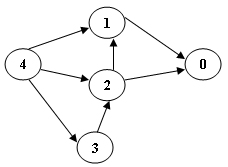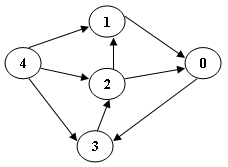Topological Sort (25分)
Write a program to find the topological order in a digraph.
Format of functions:
bool TopSort( LGraph Graph, Vertex TopOrder[] );
where LGraph is defined as the following:
typedef struct AdjVNode *PtrToAdjVNode;
struct AdjVNode{
Vertex AdjV;
PtrToAdjVNode Next;
};
typedef struct Vnode{
PtrToAdjVNode FirstEdge;
} AdjList[MaxVertexNum];
typedef struct GNode *PtrToGNode;
struct GNode{
int Nv;
int Ne;
AdjList G;
};
typedef PtrToGNode LGraph;
The topological order is supposed to be stored in TopOrder[] where TopOrder[i] is the i-th vertex in the resulting sequence. The topological sort cannot be successful if there is a cycle in the graph -- in that case TopSort must return false; otherwise return true.
Notice that the topological order might not be unique, but the judge's input guarantees the uniqueness of the result.
Sample program of judge:
#include <stdio.h>
#include <stdlib.h>
typedef enum {false, true} bool;
#define MaxVertexNum 10 /* maximum number of vertices */
typedef int Vertex; /* vertices are numbered from 0 to MaxVertexNum-1 */
typedef struct AdjVNode *PtrToAdjVNode;
struct AdjVNode{
Vertex AdjV;
PtrToAdjVNode Next;
};
typedef struct Vnode{
PtrToAdjVNode FirstEdge;
} AdjList[MaxVertexNum];
typedef struct GNode *PtrToGNode;
struct GNode{
int Nv;
int Ne;
AdjList G;
};
typedef PtrToGNode LGraph;
LGraph ReadG(); /* details omitted */
bool TopSort( LGraph Graph, Vertex TopOrder[] );
int main()
{
int i;
Vertex TopOrder[MaxVertexNum];
LGraph G = ReadG();
if ( TopSort(G, TopOrder)==true )
for ( i=0; i<G->Nv; i++ )
printf("%d ", TopOrder[i]);
else
printf("ERROR");
printf("\n");
return 0;
}
/* Your function will be put here */
Sample Input 1 (for the graph shown in the figure):
5 7
1 0
4 3
2 1
2 0
3 2
4 1
4 2
Sample Output 1:
4 3 2 1 0
Sample Input 2 (for the graph shown in the figure):
5 8
0 3
1 0
4 3
2 1
2 0
3 2
4 1
4 2
Sample Output 2:
ERROR
第一版的代码没有过,是因为超时,原因是我写了一个O(V^2)的算法,这道题必须要使用O(V+E)的算法。
int Incoming[MaxVertexNum];
int Queue[MaxVertexNum], head = 0, tail = 0;
bool FindNextIncomingZero(LGraph Graph) {
for (int i = 0; i < Graph->Nv; i++) {
if (!Incoming[i]) Queue[tail++] = i, Incoming[i]--;
}
}
bool TopSort(LGraph Graph, Vertex TopOrder[]) {
for (int i = 0; i < Graph->Nv; i++) {
for (PtrToAdjVNode ptr = Graph->G[i].FirstEdge; ptr != NULL; ptr = ptr->Next) {
Incoming[ptr->AdjV]++;
}
}
FindNextIncomingZero(Graph);
int temp = 0;
while (head < tail) {
TopOrder[temp++] = Queue[head++];
for (PtrToAdjVNode ptr = Graph->G[Queue[head - 1]].FirstEdge; ptr != NULL; ptr = ptr->Next) {
Incoming[ptr->AdjV]--;
}
FindNextIncomingZero(Graph);
}
return temp==Graph->Nv;
}
注意到其实在第一版的代码中FindNextIncomingZero这个函数是多余的,完全可以把这个函数合并到while循环中,这样就好了:
int Incoming[MaxVertexNum];
int Queue[MaxVertexNum], head = 0, tail = 0;
bool TopSort( LGraph Graph, Vertex TopOrder[] ){
for(int i=0;i<Graph->Nv;i++)
for(PtrToAdjVNode ptr = Graph->G[i].FirstEdge;ptr!=NULL;ptr = ptr->Next)
Incoming[ptr->AdjV]++;
for(int i=0;i<Graph->Nv;i++)
if(!Incoming[i]) Queue[tail++] = i,Incoming[i]--;
int temp=0;
while(head<tail){
TopOrder[temp++]=Queue[head++];
for(PtrToAdjVNode ptr = Graph->G[Queue[head-1]].FirstEdge;ptr!=NULL;ptr = ptr->Next)
if(!--Incoming[ptr->AdjV]) Queue[tail++] = ptr->AdjV,Incoming[ptr->AdjV]--;
}
if(temp!=Graph->Nv) return false;
return true;
}




